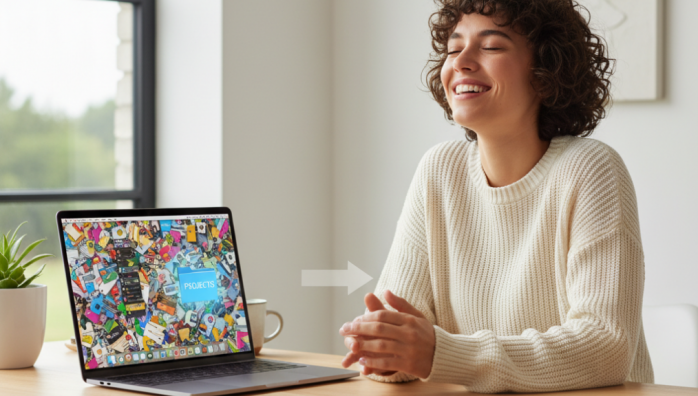The One-Touch Rule: How I Finally Conquered My Digital Clutter
by admin in Productivity & Tools 18 - Last Update November 25, 2025

For years, my digital life was a barely-controlled disaster. My desktop looked like a digital yard sale, my downloads folder was a graveyard of forgotten files, and my email inbox was a source of constant, low-grade anxiety. I tried everything: complex folder systems, fancy tagging methodologies, and a revolving door of the latest productivity apps. Honestly, I spent more time organizing the work than actually doing it.
Then I stumbled upon a principle so simple, I almost dismissed it: the One-Touch Rule. It’s not a fancy app or a complicated framework. It’s a mindset shift that has brought more clarity to my workflow than anything else I’ve ever tried. And it all starts with a simple promise I made to myself.
What is the one-touch rule?
The rule is straightforward: whenever you interact with a digital item—an email, a downloaded file, a new note—you must deal with it completely in that single touch. You can’t just open it, check it, and close it to deal with later. ‘Later’ is where digital clutter is born. When you touch a file, you have to make a decision. There are only a few options: act on it, archive it, delegate it, or delete it. That\'s it.
Why my old, complicated systems failed me
I used to believe that the more complex the system, the more organized I would be. I had nested folders ten levels deep and a color-coded tagging system that needed its own instruction manual. The problem was, these systems created friction. The effort required to file a single document correctly was so high that I\'d just end up dropping it on the desktop, telling myself I\'d file it \'properly\' at the end of the day. Of course, I never did. I realized my systems were designed for an ideal, perfectly disciplined version of myself, not the real me who’s just trying to get through the day.
How i apply the one-touch rule in practice
The beauty of this rule is its application across my entire digital workspace. It\'s not a single-purpose tool, but a universal principle. Here’s how I’ve put it into action.
For email
My inbox is no longer a to-do list. When I open an email, I immediately decide its fate. Does it require a two-minute response? I do it right then. Does it need to be saved for reference? It gets archived instantly. Is it junk? Deleted. Does it represent a larger task? I use my email app\'s integration to create a task in my to-do list app, set a deadline, and then archive the email. The email itself is processed and gone from my inbox.
For digital files
My downloads folder is always empty. Always. When I download a PDF, an image, or a document, I immediately act on it. I either open it to get the information I need and then delete it, or I rename it with a clear, searchable name (e.g., \'2024-05-10-Project-Alpha-Brief.pdf\') and move it to its final destination folder. This takes about ten seconds, and it has saved me countless hours of searching for a vaguely named file I know I downloaded... somewhere.
For notes and ideas
I used to have a \'braindump\' note that was an unsearchable mess of half-thoughts. Now, when I capture an idea, the touch includes processing it. I ask myself: Is this an action? It goes into my task manager. Is this a reference for a specific project? It goes directly into that project\'s support notes. Is it just a fleeting thought that isn\'t valuable? I let it go. This single touch ensures every idea is either given a home or discarded, preventing a build-up of mental clutter.
The surprising mental benefits
Initially, I thought this was just about having a tidy desktop. But the real change was mental. By eliminating the \'I\'ll deal with this later\' pile, I removed a huge source of decision fatigue. I no longer have that nagging feeling of unfinished business lingering in the back of my mind. There’s a sense of calm and control that comes from knowing where everything is and that open loops are being closed in real-time. It’s not just about a clean workspace; it’s about a clear mind.














